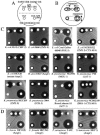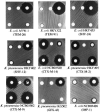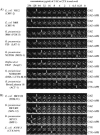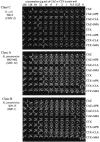Practical methods using boronic acid compounds for identification of class C beta-lactamase-producing Klebsiella pneumoniae and Escherichia coli - PubMed (original) (raw)
Practical methods using boronic acid compounds for identification of class C beta-lactamase-producing Klebsiella pneumoniae and Escherichia coli
Tetsuya Yagi et al. J Clin Microbiol. 2005 Jun.
Abstract
Detection of the resistance mediated by class C beta-lactamases remains a challenging issue, considering that transferable plasmid-mediated class C beta-lactamases are of worldwide concern. Methods for the identification of strains that produce extended-spectrum beta-lactamases (ESBLs) or metallo-beta-lactamases (MBLs) have been developed and applied for routine use in clinical microbiology laboratories, but no practical methods for identification of plasmid-mediated class C producers have been established to date. We therefore developed three simple methods for clinical microbiology laboratories that allow identification of plasmid-mediated class C beta-lactamase-producing bacteria using a boronic acid derivative, 3-aminophenylboronic acid (APB), one of the specific inhibitors of class C beta-lactamases. Detection by the disk potentiation test was based on the enlargement of the growth-inhibitory zone diameter (by greater than or equal to 5 mm) around a Kirby-Bauer disk containing a ceftazidime (CAZ) or a cefotaxime (CTX) disk in combination with APB. In a double-disk synergy test, the discernible expansion of the growth-inhibitory zone around the CAZ or the CTX disk toward a disk containing APB was indicative of class C beta-lactamase production. A greater than or equal to eightfold decrease in the MIC of CAZ or CTX in the presence of APB was the criterion for detection in the microdilution test. By using these methods, Escherichia coli and Klebsiella pneumoniae isolates producing plasmid-mediated class C beta-lactamases, ACT-1, CMY-2, CMY-9, FOX-5, LAT-1, and MOX-1, were successfully distinguished from those producing other classes of beta-lactamases, such as ESBLs and MBLs. These methods will provide useful information needed for targeted antimicrobial therapy and better infection control.
Figures
FIG. 1.
DDST and disk potentiation test for class C β-lactamase producers. (A) Scheme of disk arrangement for the two tests. The upper three disks are for DDST, and the lower two are for the disk potentiation test. The amount of APB added to the disk was 300 μg. (B) Typical observations of the growth-inhibitory zones among class C β-lactamase producers. The growth-inhibitory zones are expanded toward the APB disk in DDST. In the disk potentiating test, the diameter of the growth-inhibitory zone is expanded around the disk containing both CAZ and APB compared with that around the disk containing solely CAZ. (C) Practical changes in the morphologies or the diameters of the growth-inhibitory zones among the class C β-lactamase-producing strains. Expansion of the growth-inhibitory zone toward the APB disk is observed around the disks containing CAZ or CTX in DDST (upper) among the class C β-lactamase producers. In the disk potentiation test (lower), enlargement of the diameter of the growth-inhibitory zone of greater than or equal to 5 mm is seen among all class C β-lactamase producers except K. pneumoniae BronxLebanon 18. (D) DDST and disk potentiation test against chromosomal AmpC producers. Similar findings are observed among gram-negative rods that produce chromosomally encoded inducible AmpC type β-lactamases, suggesting that the new identification method described in the present study can also be applied to chromosomal AmpC producers, as well as plasmid-mediated class C β-lactamase producers.
FIG. 2.
DDST (upper) and disk potentiation test (lower) for non-class C β-lactamase producers. No apparent changes in the shapes or the diameters of the growth-inhibitory zones around the disks containing CAZ or CTX are observed in the presence of APB (300 μg per disk). The arrangement of the disks was as described for Fig. 1.
FIG. 3.
Microdilution test with APB for detection of class C β-lactamases. APB was added to serial dilutions of CAZ or CTX, and the concentration of ABP in each well is 300 μg/ml. (A) Detection of plasmid-mediated class C β-lactamases in representative E. coli and K. pneumoniae isolates and chromosomal AmpC β-lactamase in H. alvei EE47. An eightfold or greater decrease in the MIC of CAZ or CTX with the addition of APB is indicative of the production of class C β-lactamases. (B) Negative results of microdilution test by using APB for E. coli and K. pneumoniae isolates producing class A ESBLs or a class B MBL, IMP-1. Among the strains tested, the level of resistance to cefotaxime was reduced in the presence of APB in a few strains, such as CTX-M-9-producing E. coli AYW-3; and the coproduction of chromosomal AmpC was suspected in this strain. It may even be possible to distinguish strains that chiefly produce a class A or a class B enzyme, together with a small amount of a class C enzyme, from those that mainly produce class C enzymes when the breakpoint was set at a decrease in the MIC of greater than or equal to eightfold (three tubes) in the presence of APB. White vertical bars between the wells indicate the upper limit of bacterial growth in each line.
FIG. 4.
Microdilution test using three inhibitors for detection of presumptive β-lactamase types. Three inhibitors, APB (300 μg/ml), CLA (4 μg/ml), and SMA (300 μg/ml), were added in each line of the wells. The inhibition patterns of each inhibitor for strains producing class A, class B, and class C β-lactamases are demonstrated by using cefotaxime and ceftazidime as indicators. White vertical bars between the wells indicate the upper limit of bacterial growth in each line.
Similar articles
- Characterization of clinical isolates of Klebsiella pneumoniae from 19 laboratories using the National Committee for Clinical Laboratory Standards extended-spectrum beta-lactamase detection methods.
Steward CD, Rasheed JK, Hubert SK, Biddle JW, Raney PM, Anderson GJ, Williams PP, Brittain KL, Oliver A, McGowan JE Jr, Tenover FC. Steward CD, et al. J Clin Microbiol. 2001 Aug;39(8):2864-72. doi: 10.1128/JCM.39.8.2864-2872.2001. J Clin Microbiol. 2001. PMID: 11474005 Free PMC article. - Laboratory identification, risk factors, and clinical outcomes of patients with bacteremia due to Escherichia coli and Klebsiella pneumoniae producing extended-spectrum and AmpC type β-lactamases.
Tsui K, Wong SS, Lin LC, Tsai CR, Chen LC, Huang CH. Tsui K, et al. J Microbiol Immunol Infect. 2012 Jun;45(3):193-9. doi: 10.1016/j.jmii.2011.11.003. Epub 2012 May 12. J Microbiol Immunol Infect. 2012. PMID: 22580086 - Class I beta-lactamases. Induction and derepression.
Phillips I, Shannon K. Phillips I, et al. Drugs. 1989 Apr;37(4):402-7. doi: 10.2165/00003495-198937040-00002. Drugs. 1989. PMID: 2661193 Review. No abstract available. - beta-Lactamases: targets for drug design.
Coulton S, François I. Coulton S, et al. Prog Med Chem. 1994;31:297-349. doi: 10.1016/s0079-6468(08)70023-7. Prog Med Chem. 1994. PMID: 8029477 Review. No abstract available.
Cited by
- Aromatic Diboronic Acids as Effective KPC/AmpC Inhibitors.
Krajewska J, Chyży P, Durka K, Wińska P, Krzyśko KA, Luliński S, Laudy AE. Krajewska J, et al. Molecules. 2023 Oct 31;28(21):7362. doi: 10.3390/molecules28217362. Molecules. 2023. PMID: 37959781 Free PMC article. - Emergence of a colistin-resistant KPC-2-producing Klebsiella pneumoniae ST258 clone in Hungary.
Tóth A, Damjanova I, Puskás E, Jánvári L, Farkas M, Dobák A, Böröcz K, Pászti J. Tóth A, et al. Eur J Clin Microbiol Infect Dis. 2010 Jul;29(7):765-9. doi: 10.1007/s10096-010-0921-3. Epub 2010 Apr 18. Eur J Clin Microbiol Infect Dis. 2010. PMID: 20401676 - Detection of ESBL among AmpC producing enterobacteriaceae using inhibitor-based method.
Bakthavatchalu S, Shakthivel U, Mishra T. Bakthavatchalu S, et al. Pan Afr Med J. 2013;14:28. doi: 10.11604/pamj.2013.14.28.1347. Epub 2013 Jan 20. Pan Afr Med J. 2013. PMID: 23504148 Free PMC article. Retracted. - Prevalence of AmpC and other beta-lactamases in enterobacteria at a large urban university hospital in Brazil.
da Silva Dias RC, Borges-Neto AA, D'Almeida Ferraiuoli GI, de-Oliveira MP, Riley LW, Moreira BM. da Silva Dias RC, et al. Diagn Microbiol Infect Dis. 2008 Jan;60(1):79-87. doi: 10.1016/j.diagmicrobio.2007.07.018. Epub 2007 Sep 27. Diagn Microbiol Infect Dis. 2008. PMID: 17900845 Free PMC article.
References
- Bauernfeind, A., Y. Chong, and S. Schweighart. 1989. Extended broad-spectrum β-lactamase in Klebsiella pneumoniae including resistance to cephamycins. Infection 17:316-321. - PubMed
Publication types
MeSH terms
Substances
LinkOut - more resources
Full Text Sources
Other Literature Sources
Research Materials



